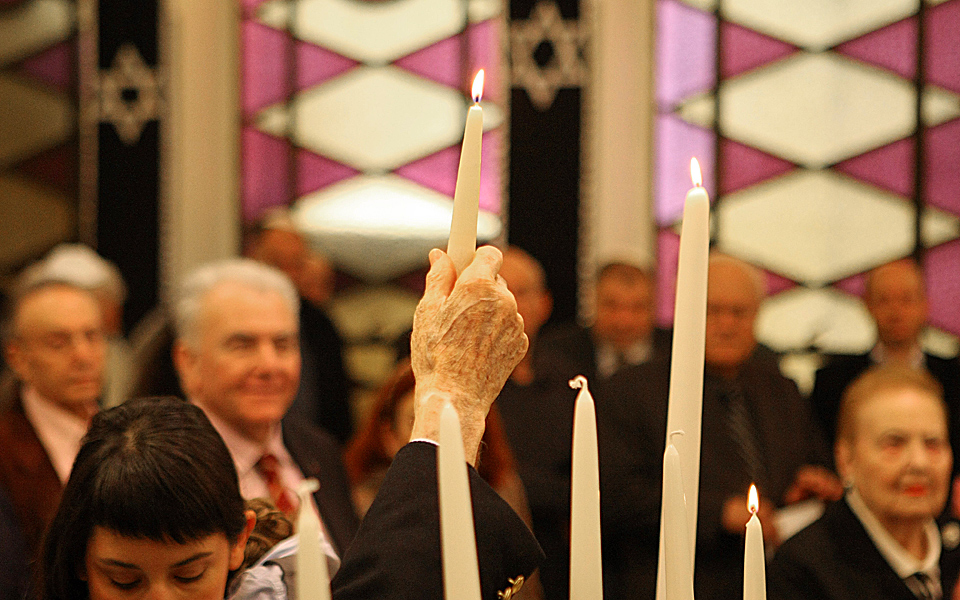Children held the flag of Israel. Odes and hymns for David flooded throughout the synagogue. Hands held the Mezuzah parchments of prayer inscribed with religious texts, including those of Rabbi Aaron Israel, Chief Turkish Rabbi Hakham Bashi Ishak Haleva and Israeli Ambassador to Greece, Irit Ben-Abba.
The Jewish heikal (sanctuary) opened again. Hymns accompanied the procession of the Hachnasat Sefer Torah in the welcoming of the new religious handwritten Torah scrolls to their new home. The members of the congregation touched the edge of their tallit to the Sefer Torah, and then kissed it as a sign of respect. Prayers, Sephardic songs (by Marty Eisenstein), the Hatikva national anthem, and official welcomes with messages of peace filled the room. Rich and powerful rituals accompanied the inauguration of the renovated Monastir Synagogue that stands as a symbol of Thessaloniki’s strong former Jewish presence.
Eighty-nine years after it was first built, the synagogue on Syngrou Street opened its doors again on May 14, to coincide with the anniversary of Israel’s Declaration of Independence in 1948. The synagogue is the only thing that remains of Thessaloniki’s rich Jewish past following the Nazi destruction during World War II, and has become a post-war symbol of the decimated community.
At this second opening, it sparkled with radiance, outside and within. New colors and finishes were added to accentuate the initial design and its symbolic characteristics (the star of David, the seven-branched menorah candlestick), and work was also done on its façade, marked with Byzantine and more eastern influences.
Renovation, thanks to the support of Germany and US-based realtor Herb Simon via the Herbert Simon Family Foundation, was undertaken by the architects Ilias Messinas, Dimitris Raidis and Alexandros Kouloukouris. Mild artistic interventions were aimed at showcasing the eclectic character of the main prayer hall on the ground floor, while decorative motifs were accentuated – such as the murals in the ezrat nashim (women’s quarter), the stained glass windows, and the marble fixtures.
“The synagogue is the only thing that remains of Thessaloniki’s rich Jewish past following the Nazi destruction during World War II, and has become a post-war symbol of the decimated community.”

New openings and windows were added to bring more light to the space, aiding in the newest highlight – a small display area that narrates the history of the synagogue, exhibits sacred objects. Items here include prayer books from the 18th and 19th centuries (with an 1876 edition salvaged from the Warsaw Ghetto); ornate Sepharad and Ashkenaz-styled mezuzot prayer parchments; and two marble tablets featuring the 10 Commandments which used to decorate the main arch of the synagogue but were taken away after they collapsed during an earthquake. Before renovation, the passing of time had caused certain architectural characteristics to fade. “The building, as the center of Jewish life, didn’t have force. Our approach was to awaken its history. The changes are all reversible. We didn’t touch any of their features. We just showcased them while maintaining their frugality,” says Ilias Messinas, one of the three architects, speaking to Greek daily Kathimerini. “We were inspired by the renovations of synagogues around Europe, the Former Yugoslav Republic of Macedonia (FYROM), and Turkey.” These [places] were also the source of inspiration for the initial design of the synagogue by architect Eli Levy.
Built in 1926 by Monastir Jews from the area of Bitola (now in southwestern FYROM) who migrated to Thessaloniki after World War I, its erection was made possible by donations from the prominent Aroesti family of benefactors. It was one of the 59 synagogues and prayer rooms (midrashim) used by the prosperous and robust community of 50,000 Jews in Thessaloniki prior to World War II.
The building was saved from destruction during World War II by the Red Cross, which it converted into a warehouse. The first survivors came here to mourn the victims of the Holocaust, before beginning to establish their community in Thessaloniki anew, despite a loss of 96 percent of their members.
“This synagogue is part of the identity of all post-war generations. It is our house, our history, our future,” said David Saltiel, head of the Israeli Community of Thessaloniki. On his part, Thessaloniki’s Mayor Yiannis Boutaris said that that the re-opening of the synagogue is “just a pebble” (one step of many), in an effort to expose the history of Jewish residents in the historical city, while also pointing out that there are plans to create a Holocaust Museum and other educational foundations, to keep alive the memory of those who disappeared.
Originally published in Kathimerini
“We were inspired by the renovations of synagogues around Europe, the Former Yugoslav Republic of Macedonia (FYROM), and Turkey.” These [places] were also the source of inspiration for the initial design of the synagogue by architect Eli Levy.”











